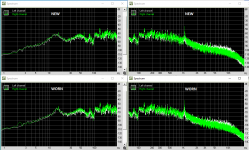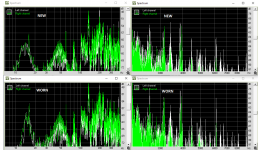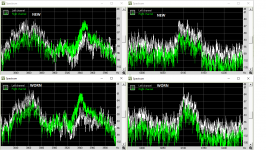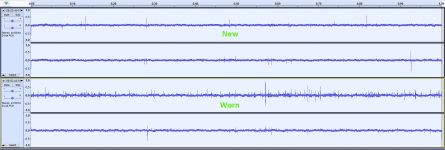Bill
Low repeatability is common when recording vinyl takes. That said
On NEW, arm/cartridge resonance peak is broader and lower in amplitude than on the WORN.
Up to ~800Hz, music peaks are of the same amplitude on both recordings. Above that frequency, music peaks start increasing on WORN (1dB at 1100Hz, 2 to 3 dB above 3kHz)
When zooming in, shape of FFT is different on these two recordings.
Both recordings show you are running a bit low in speed . 30.0 rpm (based on eccentricity peaks which are 0.50Hz apart)
Eccentricity peak on NEW is 4.5dBpp, on WORN it is 5.5dBpp.
My bad ears can hear more scratching noise on the WORN file.
>edit. FFT size: 262144 samples
George
Low repeatability is common when recording vinyl takes. That said
On NEW, arm/cartridge resonance peak is broader and lower in amplitude than on the WORN.
Up to ~800Hz, music peaks are of the same amplitude on both recordings. Above that frequency, music peaks start increasing on WORN (1dB at 1100Hz, 2 to 3 dB above 3kHz)
When zooming in, shape of FFT is different on these two recordings.
Both recordings show you are running a bit low in speed . 30.0 rpm (based on eccentricity peaks which are 0.50Hz apart)
Eccentricity peak on NEW is 4.5dBpp, on WORN it is 5.5dBpp.
My bad ears can hear more scratching noise on the WORN file.
>edit. FFT size: 262144 samples
George
Attachments
Thanks all for the analysis. I'm still trying to work out what it tells us. I was originally convinced that the additional noise was due to tracking the groove floor, but the worn stylus contact patch does literally go from bottom to top so it's possible that the noise is higher up. With the lapping test not possible we won't know.
The simplest test would be a distortion against frequency plot. Distortion should increase at higher frequencies when the stylus is poorly shaped.
I'd also expect gross mis-tracking to kick in at lower amplitudes too.
Another interesting question is does playing high level recordings lead to less problematic wear (playing silent vinyl would clearly wear the stylus into a rectangle cross-section, which is the least nice option, so playing higher volumes should give more rounded wear). Perhaps
some old DJ stylus's would be interesting to put under the microscope.
I'd also expect gross mis-tracking to kick in at lower amplitudes too.
Another interesting question is does playing high level recordings lead to less problematic wear (playing silent vinyl would clearly wear the stylus into a rectangle cross-section, which is the least nice option, so playing higher volumes should give more rounded wear). Perhaps
some old DJ stylus's would be interesting to put under the microscope.
I've been able to test out old vs. new stylus and turntable mods inadvertently. I had ripped two records about 7-8 years ago in 24/96 and in playing the files recently on my current streaming setup could hear every flaw in the rip. I then played the same two on the original vinyl on my current setup and it sounded much better, quieter background, extended frequency range due to better cartridge and better motor setup. I then also played the same two over Qobuz, one in 24/96 the other CD quality and thought the current vinyl sounded best, but not by much.
The two were Joni Mitchell's "Court and Spark" and Suzanne Vega's "Solitude Standing". Ironically, "Tom's Diner" is the cut used by the MP3 developers to get MP3 to sound right, but Ms. Vega never thought they really did. On top of that, I saw her perform it on NPR's Tiny Desk and she sings the version as DNA resampled it into a dance cut! YouTube
The two were Joni Mitchell's "Court and Spark" and Suzanne Vega's "Solitude Standing". Ironically, "Tom's Diner" is the cut used by the MP3 developers to get MP3 to sound right, but Ms. Vega never thought they really did. On top of that, I saw her perform it on NPR's Tiny Desk and she sings the version as DNA resampled it into a dance cut! YouTube
Last edited:
Could you please tell how you got the noise spectra of the blank groove, from where to where in time did you analyse the recordings ?Tough break Bill - literally!
I went over the New and Worn files to find differences. I assume that you left everything the same and just swapped the stylus.
Cheers
Noise from an LP is white starting from somewhere at 100Hz and upwards, just like 1/f noise with a corner frequency of 100hz.
When playing this over a Riaa preamp, one will immediately recognise the Riaa Curve, which I can't see here.
From 2kHz to 20Khz, noise should drop with 20dB and only the ca. 10db in your image is quite a bit unexpected.
Hans
I went again in the new and a worn needle files that Bill provided, taking the part from zero to one second, assuming that this is still the silent lead in groove.
First I applied an Anti Riaa correction, expecting to get a flat white noise curve somewhere above the corner frequency.
Then I amplified the signal by 30dB, to get a better view on the time signal.
Quite interesting to see is that of the recording with the worn needle, the left channel produces much more clicks as the right channel, see first image below.
The right channel of the worn needle however produces roughly the same amount of clicks as both channels from the new needle.
This is probably more or less to be expected from a non linear tracking arm.
Because of these clicks, I removed them with a click removal filter.
After that I produced the spectra of both recordings.
What can be seen is that the corner frequency lies at ca 500Hz, and from thereon the noise is relatively flat with a slight sag of -3dB around 4kHz.
I hold the recording chain responsible for this slight sag.
But at least the level at 1kHz is the same as at 20kHz, where the Anti Riaa correction is almost 20dB.
In the spectra, the second image below, we see the same as in the time signal, the left channel of the worn needle produces slightly more noise as the right channel.
The Right Channel of the worn needle is quite comparable in noise as both channels of the new needle.
Hans
First I applied an Anti Riaa correction, expecting to get a flat white noise curve somewhere above the corner frequency.
Then I amplified the signal by 30dB, to get a better view on the time signal.
Quite interesting to see is that of the recording with the worn needle, the left channel produces much more clicks as the right channel, see first image below.
The right channel of the worn needle however produces roughly the same amount of clicks as both channels from the new needle.
This is probably more or less to be expected from a non linear tracking arm.
Because of these clicks, I removed them with a click removal filter.
After that I produced the spectra of both recordings.
What can be seen is that the corner frequency lies at ca 500Hz, and from thereon the noise is relatively flat with a slight sag of -3dB around 4kHz.
I hold the recording chain responsible for this slight sag.
But at least the level at 1kHz is the same as at 20kHz, where the Anti Riaa correction is almost 20dB.
In the spectra, the second image below, we see the same as in the time signal, the left channel of the worn needle produces slightly more noise as the right channel.
The Right Channel of the worn needle is quite comparable in noise as both channels of the new needle.
Hans
Attachments
Thanks Hans. That what I saw, too. More pops and ticks on the worn left channel. That made me wonder if it was the stylus, or if the dirt was different in the two passes.
Still, the new stylus recording is noticeably quieter than the worn, both in measurement and to the ear. Overall FR isn't much different, but noise certainly is.
Still, the new stylus recording is noticeably quieter than the worn, both in measurement and to the ear. Overall FR isn't much different, but noise certainly is.
- Status
- This old topic is closed. If you want to reopen this topic, contact a moderator using the "Report Post" button.
- Home
- Source & Line
- Analogue Source
- analysing worn vs new stylus rips




